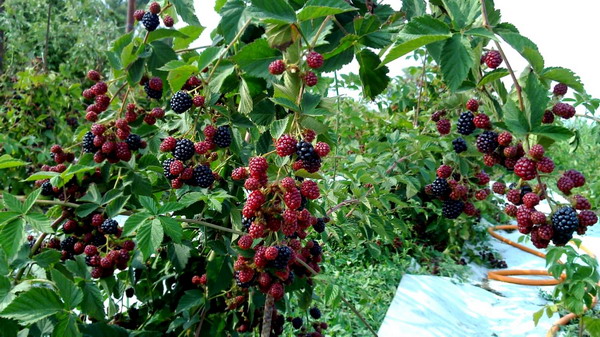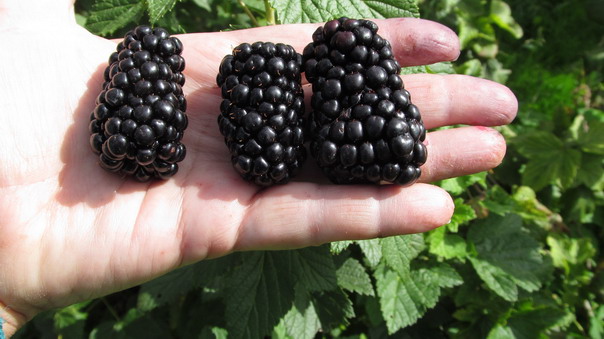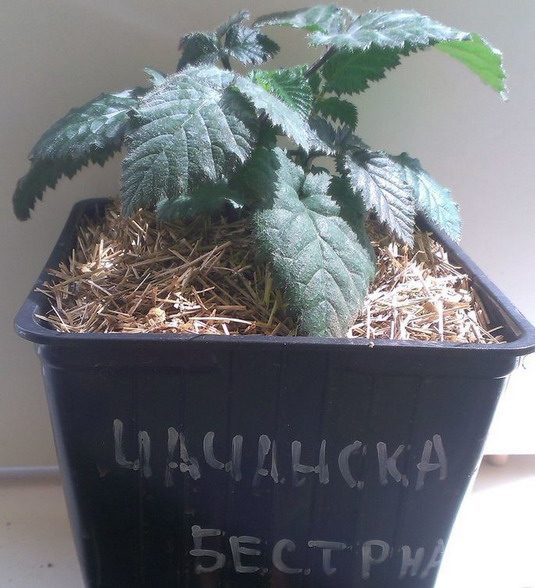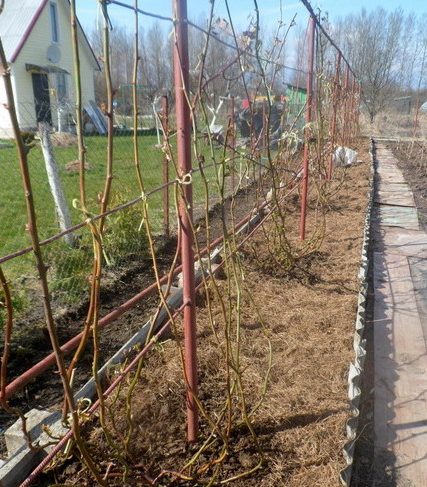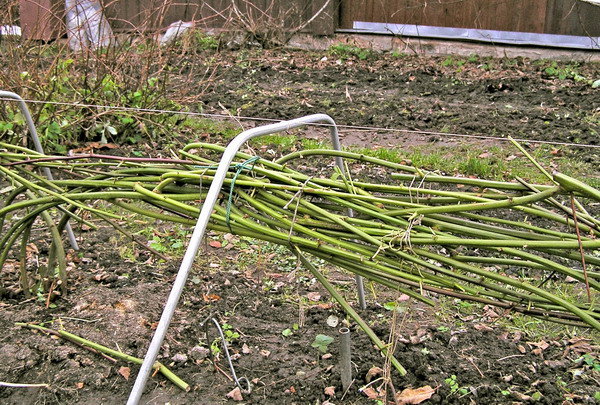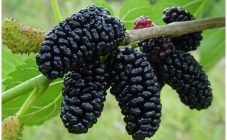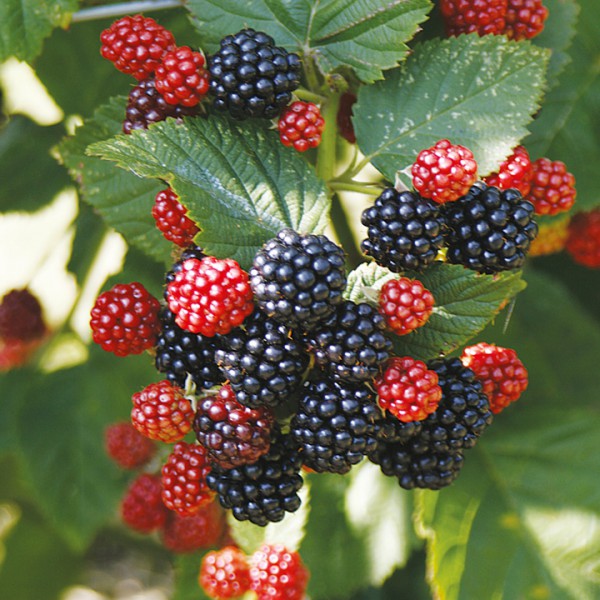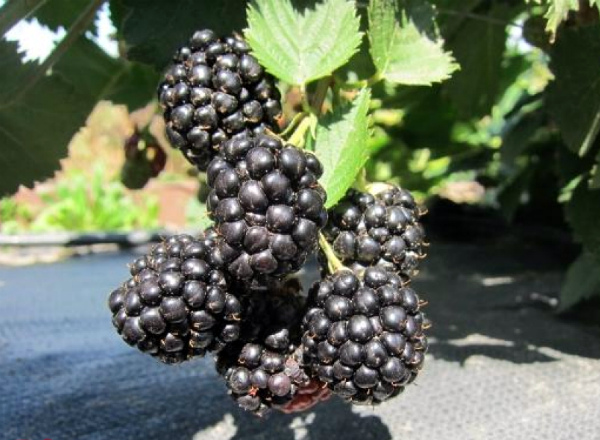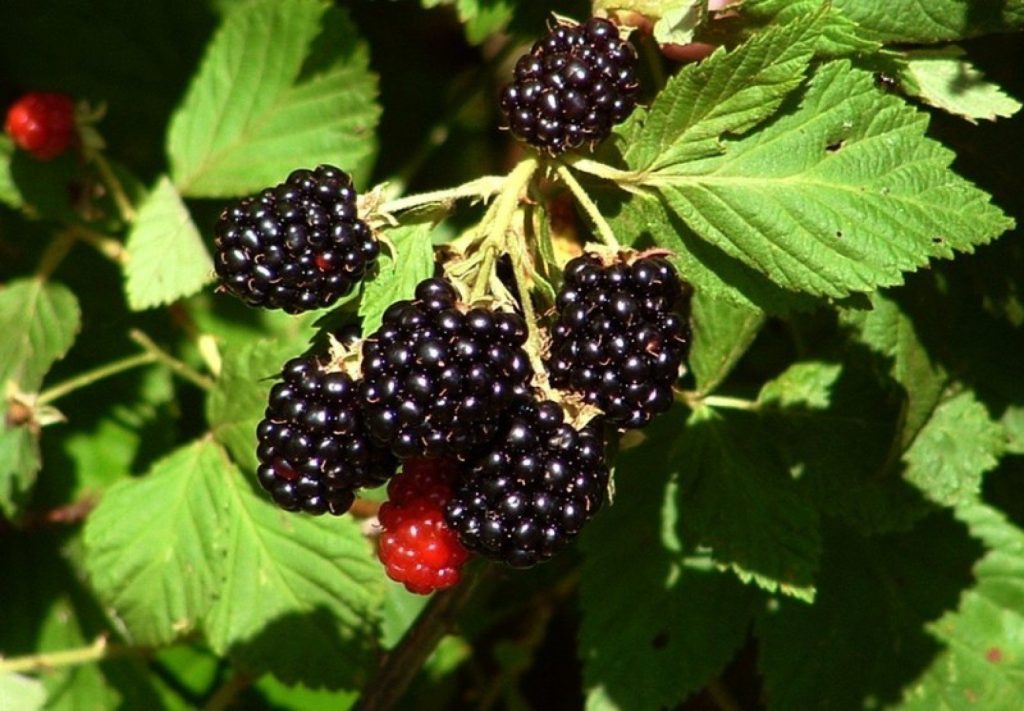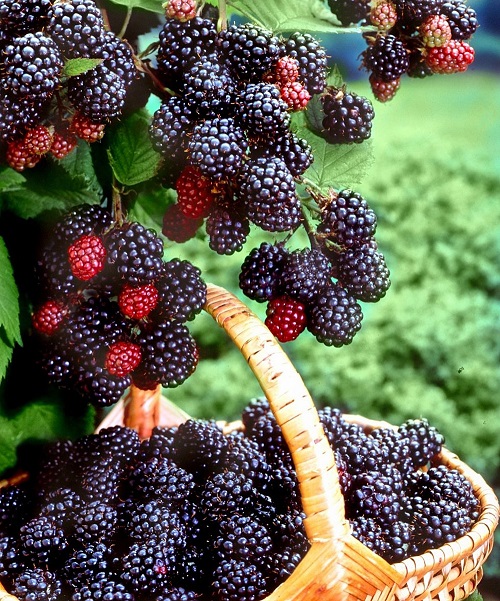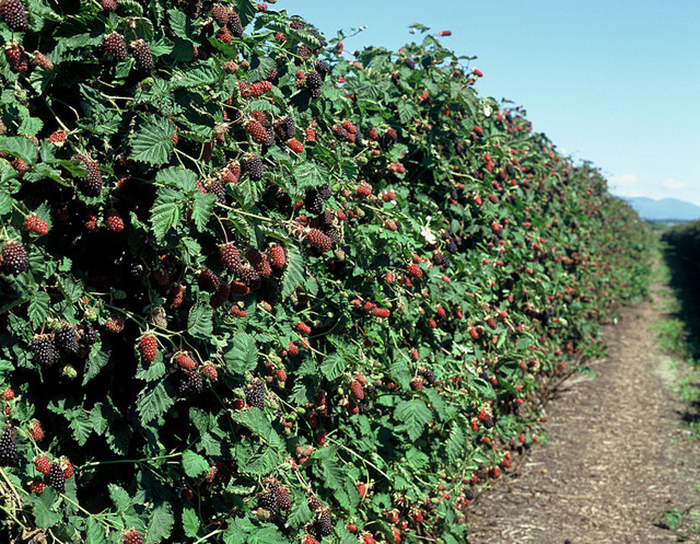Content:
Blackberries have long been known for their beneficial properties. But picking this berry, growing in the wild, is quite difficult, as the wild plant is famous for its sharp thorns. Not so long ago, breeders have bred several varieties of thornless blackberries. The advantage of this culture is the absence of sharp thorns and thorns, which greatly simplifies the collection of fruits and caring for the plant. Also, the species is characterized by high productivity, large berry size (depending on the variety), good resistance to pests and diseases.
Characteristics of thornless blackberry
The closest relative of the blackberry is the raspberry, both of which belong to the Pink family. On a large scale, the cultivation of this crop in our region has not received much distribution, but it is in great demand among summer residents.
Outwardly, thornless blackberry resembles a small shrub with bright serrated green leaves of medium size, divided into 3 parts and "looking" down. The plant begins to bloom in the first half of June, its flowers are small, pink-purple in color, about 2 cm in diameter. Then, in place of the flowers, small green berries appear, which gradually change their color, becoming bright purple. This is the signal for full maturity. Ripening occurs unevenly, therefore, berries of a variety of colors can often be present on one bush. The yield of the crop is quite large and can exceed by several times the yield of its closest relative, raspberries.
The beautiful blackberry has a very developed root system, directed down to 1.5-2 meters. Accordingly, most varieties survive dry times well.
Breeders conditionally divide blackberry crops into three groups, depending on the method of growth:
- Shrub blackberry, characterized by growth up to 2, and sometimes 3 meters. You can distinguish such varieties as Apache, Guy, Orcan, etc .;
- Climbing blackberry, characterized by the growth of shoots directed parallel to the ground, their length can reach 4-6 meters. It is possible to distinguish the blackberry bushy of such varieties as Black Satin, Thornfrey, Loch Ness, etc .;
- Semi-growing blackberries, characterized by an initial growth of 0.5 meters, and then the growth of shoots rushes down, thus the Triple Crown variety grows.
Blackberries are most often characterized by a bright dark purple hue, but varieties with yellow or red fruits are also bred. The size varies depending on the species. The structure is dense, with a sweet, rich taste, the shape is elongated and conical. Fruiting begins only from the second year.
Blackberries grow in almost any part of Russia: in the Voronezh, Rostov regions and even in the Moscow region. But in each region, the taste of the berries is different. So, in a warmer climate in the Crimea and Kuban, the berries are sweeter - a large amount of sun affects. Berries grown in the Urals and Siberia have a more sour taste. For this region, special more winter-hardy varieties are required, for example, Polar, Ruben, Agavam.
Blackberry non-covering, thornless is rich in vitamins, has a beneficial effect on blood pressure, the digestive tract, the immune system, perfect for baking, stewed fruit, jam, jam.
Features of planting and growing
Breeders have bred a variety of blackberry varieties, the proper care of which directly depends on the volume of the crop. Therefore, thornless blackberry care, cultivation, reproduction and pruning, is mandatory, some varieties have their own specifics.
Important! The sweetness of the blackberry is directly related to the illumination of the area. The more sun hits the plant, the sweeter the fruit will taste. Therefore, breeders recommend choosing places for the site where direct sunlight is unhindered.
Important! The cultivation of blackberries depends on the correct planting season. In the Moscow region and the Leningrad region, in the southern regions and the middle lane, planting is carried out in the fall, a month before the first frost. In the Urals and Siberia, we plant plants in spring at temperatures no higher than 15 degrees. Seedlings that tolerate frost well can be planted in autumn, with low frost resistance - you need to plant only in spring.
The soil for planting is prepared in the fall: it is dug up, deepening at least 25 cm. In this case, the plant is planted in the spring. Preferred soil rich in humus. You can fertilize the soil yourself, sprinkling it abundantly with ash or dry lime before digging.
In order for the seedlings to take root well, it is worth giving preference to annuals with several stems, about 5-10 mm thick, and a developed root system, at least 10 cm long. Before planting a cutting, experienced gardeners recommend slightly shortening the roots, as well as removing damaged and “dead »Parts.
It is necessary to plant seedlings in a hole with a diameter and depth of at least 0.5 meters and a distance of about a meter from each other. If a climbing bramble is planted, the care for it, in order to be correct, will require at least 4-5 meters. The soil is pre-fertilized. For this, superphosphate is mixed in an amount of 100 g. and 35 gr. potassium. As a fertilizer, you can use humus from bird droppings. It is placed at the bottom of the pit, sprinkled with earth by 10-15 cm (in this case, the depth of the mind increases by 25-30 cm so that there is no direct contact of humus with the roots of the plant). On average, one seedling is about a bucket of humus. You can mix the earth with ash, you need about 80-100 gr.
The seedling is planted in such a way that the root collar deepens by no more than 1-1.5 cm. Then the seedling is abundantly watered with 4-5 liters of water, having made a hole in advance. Experienced gardeners recommend after cutting off the shoots so that no more than 6-8 cm remains above the ground.
It is worth considering that a properly planted plant will bear fruit for at least 10-15 years.
Blackberry breeding methods
Breeding blackberries at home is possible in several ways:
- Propagation by cuttings. In August, the tip of a young one-year shoot is pinched off to 2 cm.All foliage is carefully removed from the same shoot. The shoot is bent to the ground and buried in 10 cm. Weekly watering is required. After a month, the shoot should take root. It is recommended to separate it from the main shrub only in the spring;
- Reproduction with shoots is carried out in July. The largest and longest branches are selected, an incision is made on them with a sharp knife, which is buried 10 cm into the ground. The tops with foliage are not covered with soil. Roots appear at the incision site after a while. By autumn, the sprouts can be separated and planted in a prepared place;
- It is also possible to grow with seeds that are sown in fertile soil. But for home breeding of blackberries, this method is rather complicated.
Thornless blackberry varieties
To date, breeders have bred more than 100 varieties of blackberries that are in great demand around the world. The best and most often demanded among them can be distinguished:
- Loch Ness - was bred in Scotland back in the 80s of the last century.This variety grows as a shrub up to 2 meters high and shoots up to 4 meters long (in this case, supports are required for support). The weight of a ripe berry can reach 5 grams, it is perfectly transported. It attracts gardeners with a good yield - about 30 kg of fruits can be harvested per season. High resistance to pests is observed;
- Thornfree - grows as a bush. The variety was bred in the 60s of the last century in America. The cultivation of this species attracts gardeners with its great resistance to pests and fruiting from July to early September. The characteristic flavor of the berries is sweet and sour. During the season, it yields up to 20 kg. It is recommended to pick berries as they ripen, otherwise the fruit loses its elasticity;
- Black Satin - characterized by berries of an almost black hue with a sour taste. This variety grows well in the shade in the form of a shrub up to 1.5 meters high, has increased frost resistance. About 15 kg of berries can be harvested from a bush per season;
- Navajo - characterized by medium-sized berries, their weight fluctuates between 4-5 grams, but is compensated by a large number of berries - their number on a bush can reach up to 1500 pieces. This species was bred in America, has good resistance to frost, gives a large harvest per season (from August to September);
- Smutsttstem - has especially large berries, which can reach 10 grams, fruiting occurs in the summer in the southern regions, in the northern regions - the harvest is harvested from August to September. It has an average winter hardiness, therefore, it requires mandatory preparation for wintering.
Bush care and preparation for winter
To grow a beautiful blackberry at home, you will need simple care, which includes: fertilizing the soil, watering, garter, thinning, creating support.
Every year, with the arrival of warm spring days, it is recommended to fertilize the ground around the bush with humus (1/2 bucket) or saltpeter (50-60 grams), digging everything up with the soil. In autumn, about 100 grams of ash can be added to the soil. on the bush.
After rain, it is recommended to loosen the soil around the bush and remove weeds, thereby enriching the roots with oxygen. But this should be done only with young shoots - in adult plants there is a high probability of damaging the root system, which will negatively affect their growth.
Particular attention should be paid to moistening the soil in June, as well as September and October, watering is required at least 1 time per week at the rate of about 5 liters of water per bush. At other times of the year, the thornless blackberry variety can perfectly do without moisture.
Crop varieties that grow up require minimal maintenance, but semi-creeping and climbing plants will require the creation of additional supports, which can be made independently using pegs and wire about 4-5 meters (the wire is pulled between the pegs in 3 rows) or factory-made trellises. Fruit-bearing shoots are recommended to be tied up as much as possible, and young ones - to be fixed to the lower tier of the trellis.
To increase the yield, it is recommended to cut off young shoots, the height of which has reached 120 cm. The tops are pinched about 20-25 cm. The procedure is best carried out in early May, as well as in early spring. In the autumn after harvesting, all fruiting branches are carefully cut.
You need to take care of the plant almost throughout the year. Preparation for the winter period is no exception.
The uncovering, thornless blackberry does not require special preparation for winter. These varieties include remontant crops growing in the form of shrubs.
The exception is crops that do not tolerate cold weather. In this case, young shoots need to be bent to the ground and carefully covered with any white non-woven covering material (spunbond, agrofibre, agrospan). The density of the material directly depends on winter temperatures: it can be grade 60, 80, 100 or more. So, the Chester variety is famous for its bountiful harvest, but it is afraid of winter frosts and requires additional care.If it is covered with agrofibre, the plant will be able to withstand frosts above 20 degrees without any problems.
Today, amateur gardeners grow a variety of blackberry varieties. When choosing a type of blackberry, it is worth considering the peculiarities of climatic conditions, this factor affects the yield of the plant. In addition, it is not enough just to plant a blackberry - it requires some care and preparation for wintering. Only compliance with all the recommendations of breeders will allow you to achieve a good harvest in a year or two.
